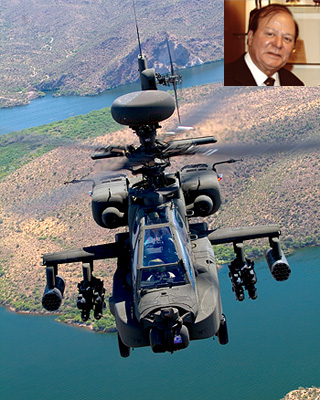INDIAN ARMED FORCES CHIEFS ON
OUR RELENTLESS AND FOCUSED PUBLISHING EFFORTS

SP Guide Publications puts forth a well compiled articulation of issues, pursuits and accomplishments of the Indian Army, over the years

I am confident that SP Guide Publications would continue to inform, inspire and influence.

My compliments to SP Guide Publications for informative and credible reportage on contemporary aerospace issues over the past six decades.
- Prime Minister witnesses 'Bharat Shakti' – a Tri-Services Firing and Manoeuvre Exercise in Pokhran, Rajasthan
- Interim Defence Budget 2024-25 — An Analysis
- Union Defence budget 2024
- Prime Minister Modi Commemorates Indian Navy Day in a Grand Ceremony
- Prime Minister Modi Flies in the LCA Tejas
- New Chapter in India-Italy Defence Ties
- Airpower beyond Boundaries
Need for Seamless Integrated Planning

Forever a victim of its die-hard habit of sensationalising any and every bit of news, the Indian media has once again tried to give an ominous twist to the inter-service relations within the armed forces. This time it has picked up the newly appointed Army Chief General Bikram Singh, who is reported to have launched an ‘aggressive’ campaign among the top echelons of the government demanding that the Army be allowed to have its own attack helicopters. And, true to its form and character, the media lost no time suggesting that the move has triggered a fresh round of stand-off between the Army and the Indian Air Force (IAF).
Before commenting on the issue, it would be worthwhile taking a closer look at the prevailing scenario and the developments already in the offing. It is common knowledge that the IAF currently fields two squadrons of Russian-built Mi-25/Mi-35 attack helicopters primarily in support of the armoured formations of the Army on as required basis. During exercises and in actual operations, these operate directly with the affiliated Army formations from forward area arming and refuelling point (FAARP) locations, thus providing the necessary synergy between the two services. These could also be used in complementary roles such as combat search and rescue, etc, when required. The IAF is known to have opted for 22 US Apache Longbow AH-64Ds, as an initial order through import to augment/replace its ageing Mi-25/Mi-35s.
On the home front, however, HAL is feverishly developing India’s own attack helicopter called the light combat helicopter (LCH) which is derived from the advanced light helicopter (ALH) Dhruv. Of note are the facts: first, ALH is already operating in the IAF as well as the Army, and second, LCH is being developed for both the services with the Army’s initial order for 114, far out-stripping the IAF’s 65.
Concurrently, the HAL is also ‘weaponising’ the Dhruv in its ALH weapon systems integrated (WSI) avatar called ‘Rudra’, to be supplied to the Army and the Navy for combat support and maritime ASW roles, respectively. Incidentally, not only the LCH but also the weaponised Rudra will have the capability to carry different types of weapon loads such as air-to-air and air-to-surface missiles, rockets, etc—even chin-mounted cannons—just like any other attack helicopter. The difference, if any, lies primarily in the all up weight (AUW) between the light combat and heavier attack helicopters. For example, the indigenous LCH and ALH (WSI) fall in the five-tonne AUW class, while the IAF’s Mi-25/Mi-35 and the to be acquired AH-64D Apache Longbow, belong to the 10-tonne+ class.
It is clear therefore that the Army is already on the way to get its own light-weight attack/combat helicopters and from that point of view media’s frenzy would be meaningless. Under the Joint Army Air Instruction of 1986, the Army is empowered to operate light utility helicopters for communication, directing artillery fire, etc. To that, it is also adding the light-weight combat helicopters in support of ‘contact battle’, etc, as mentioned above. However, major problems could arise— including for the Army—if it went pitching for the heavier specimens too.
It is not clear at this stage whether reports emanating from a section of the media that Army has demanded helicopters heavier than five tonnes, including attack choppers for itself, in the long term integrated perspective plan (LTIPP) for 2012-27, are true or not? In the same context, it has also been reported that though LTIPP for the military was approved by the Defence Acquisition Council, headed by Defence Minister A.K. Antony, in April; this aspect has been referred to a panel, headed by the Deputy Chief of the Integrated Defence Staff (Perspective Planning and Force Development) and comprising representatives from various services. In the event, these reports do turn out to be real, it is sincerely hoped the panel (in line with the IDS’ character and mandate) will not hesitate to disagree with the proposal. Because, more than preventing avoidable turf wars, such a move will do great service to the Army itself. Lack of domain expertise plus logistics and maintenance support issues could prove to be crippling factors and the Army would do well not to invite trouble at this stage.
In the final analysis, more than physical ownership, what really matters is for the services to integrate themselves for modern warfare—with each doing what it is best at—to deliver the decisive knockout combat punch against the enemy. It is believed, the Indian military planners have already articulated joint doctrines for fighting such a battle. But are they also ready to implement these through true joint planning and seamless integrated execution?





